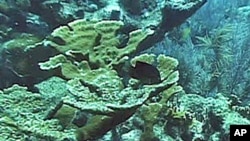The director of US National Parks says more than 40 parks and wildlife refuges on the Gulf of Mexico could be affected by the BP oil spill. He said there is no clear end to the spill at this point but he downplayed the potential impact when the slick reaches the Florida Keys. Meanwhile a scientist at the National Oceanic & Atmospheric Organization (NOAA) has warned about potential damage to the area's corals.
Eight national parks and 33 wildlife refuges along the Gulf of Mexico could be threatened by the oil spill, according to National Parks Director Jonathan Jarvis. He is helping coordinate the government's response to the spill and spoke at a hearing on Capitol Hill.
"We are at 100 percent of our planning level in terms of protection of Gulf islands, national seashore, to protect predominantly the wetlands and estuaries and sea grass beds that are on the backside of the islands," said Jonathan Jarvis.
Jarvis said teams of scientists have been deployed to assess conditions in the national parks in the Gulf. Those teams, he said, are also looking at the possible impact - short and long term - of the dispersant that BP has been using.
The oil slick has now entered the loop current that runs from the Gulf of Mexico to the Florida Keys and up the east coast of the U.S., Jarvis said. The region has the third largest barrier reef in the world. Tortugas National park is at the southern most point of the Keys.
"We think that for the South Florida parks, Dry Tortugas, Big Cypress, Everglades and Biscayne, it is predominately going to be a tar ball event because the oil is weathering," he said.
That means oil tends to lose toxicity as it travels. And, he said, tar balls are less toxic.
Jarvis said the government has been working closely with BP to better understand how the oil changes as it moves through the Gulf.
Some of the worst damage is already underway. Dense areas of deep coral that have taken hundreds of years to grow are located under the oil slick.
Scientists from the National Oceanic & Atmospheric Administration (NOAA) are assessing the situation.
Kacky Andrews, is NOAA's manager for Coral Reef Conservation. Pointing to a map of the region, she says there are deep and shallow corals throughout the Gulf of Mexico.
"They are all over the place and that's what makes the Gulf of Mexico such a rich place for fisheries," said Kacky Andrews. "Now we all know they are essentially underneath where the sheen is appearing right now."
She said coral tends to be the main habitat for many fish.
"These are the habitats that provide really valuable places for the fish to get together, to aggregate, to spawn, so they are the bases of the fisheries," she said. "It is an important piece of the economic engine of the fisheries in the Gulf of Mexico. But also these places are just remarkable in and among themselves. Some of these things are possibly over 4000 years old."
Andrews says the extent of the damage is unknown because the spill is unprecedented.
"Coral reefs only make up about one tenth of one percent of the ocean floor," said Andrews. "But they provide habitat for over 25 percent of the marine species."
For the moment, uncertainty rules the day.













